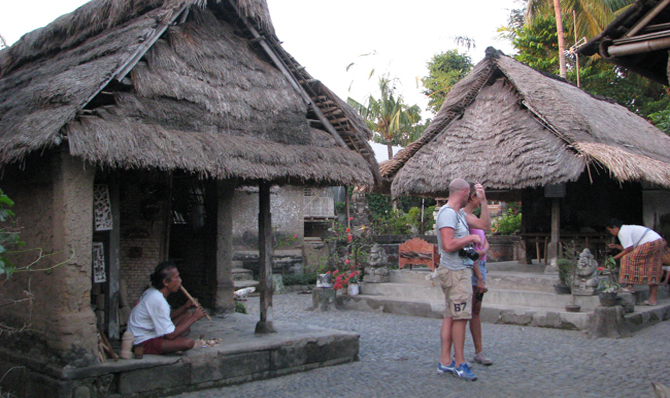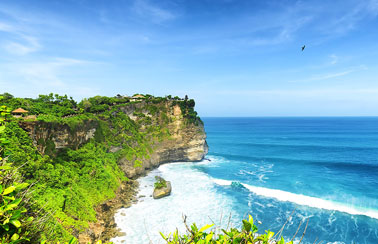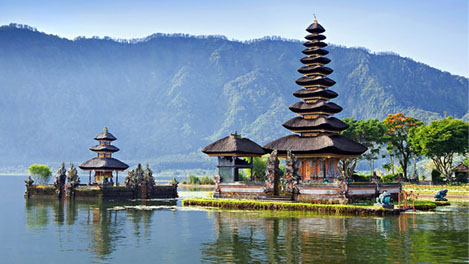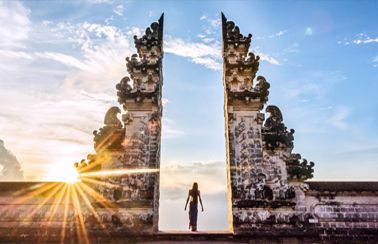Traditional Balinese House Compound in Batuan
Traditional Balinese House Compound is one of the best place to visit in Bali. That located in the village of Batuan, Gianyar regency, Bali. 45 minutes drive from Denpasar airport. The buildings are mostly designed by Balinese architectures taking daily social Balinese life concept pointing out the hospitality. It is very charming concept of house building consisted on several building with different purpose of activities.
The Balinese family compound comprises a rectangular perimeter wall and several important structures, each significant and carefully laid out. The Balinese think that the family compound reflects the human body and the first step in building a new compound is consulting a Balinese calendar to choose a suitable day to buy the land and start work.

House and Village of Balinese
There are 3 types of architecturally observable Balinese traditional houses, first is the house compound which is consist of at least 4 pavilions plus a complex of family temple.
Second is a standing alone house some time with a separate pavilion for kitchen, and the third is a housing complex, where rows of houses belong to a different families of the same leneage standing face to face at the left and right side of a slot of land.
This third type, a family usually has 2 houses, one as normal house and the other as kitchen. The first and second types are usually found at low land where people live with irrigation system. Their house compound or one standing house is normally enclosed by private wall with entrance gate called "angkul-angkul" The position of houses either in a dense complex or scattered in a long distance from one another. It is mostly built close one another except in some places which were supposed much later settlement. The third is where the houses are in a dense complex normally the settlement in highland.
The area of a settlement is normally laid out on the right and left side of a main road. both on the right and left sides of the area is divided into many slots of land (courtyard ), in Balinese this slot is called " natah". In one natah some time consists of many families with the pattern of house of each family facing each other.
Most families on a natah usually originated from one single family who has been living for many generations, from a father and mother who had developed into many family units. When a village was first established it was probably close to the forest and to maintain the safety and security of the member they had probably form a close position to facilitate instant emergency contact. Seen from the structure of the houses regardless the types mentioned above seems that Balinese had not experienced any animal endangering since their house is low, in average 40 to 50 cm foundation's height from soil level.
Element of Traditions
Building a house is not only architectural and functional consideration but there are unpractical elements which also gives special characteristic to a house, especially the position and orientation. The following thoughts are considered in constructing a chouse.
Facing road line, this is avoided and is called "tumbak rurung" literally in English means " targeted by a road-spear". There is a myth saying there is also an invisible being who also passing the road. Since the house is just like blocking the road, than the invisible being can enter the house, and making trouble to residents. If one is forced to build a house like this because of later environment changes or reconstruction, they usually build a small shrine just in front of the house toward the direction of the road. At certain days they put offering of flowers and coconut leaves to make the invisible being aware of the block. Standing alone house between 2 parallel roads on one side of the house is empty land. This position is called " Celedu Nginyah " literally means sun-bathing scorpion. This position is also avoided or put a shrine facing to the empty land if no choice. Build a house making existing house to the position between new built and family house, whose owner has no blood relation. So the space looks like being cut by other family. This position of 2 family houses putting some one else in the middle is called "ngapit", and is avoided. Build a house between road, when two families with blood relations one staying at left side, and other at right side of the road. This position is avoided, and is called "negen jalan" literally means " holding the road"..
Directly on the north side or east side of village meeting hall is also avoided. Here the understanding of north ( Bali "kaja" ) and south ( Bali "kelod" ) have additional understanding than just mere a directional concept. One important aspect of Balinese orientation is mountain. As Bali is divided by mountain range from west tip to east tip, the people of south Bali has different mountain-orientation. For those people leaving at the south to the mountain range, use the directional words exactly as the English word means. While northern Bali use the word north to refer the mountain, and south to refer the sea. So, it is in contradictory with English words, which for north Balinese resident "north" means English "south", and "south" means English "north". In other words we can say "kaja" direction is meant "south", and "kelod" direction is meant "north". While at the other side Balinese uses also these word to purely referring directions. In relation is a house position, it is avoided to build a house directly at the northern side of village meeting hall, or directly at the east of it. This position is called "ngeluanin", which contains a meaning to take a position at front of more senior people, or put ourselves at higher position. Point of orientation is not only a mountain but it can be any kind such as temple, the start of a river, river bank, beach, lake bank, or any place which is considered as sacred, and east-direction ( sun rise ). It means that when people sleep the body stretches with the head toward the "luanan" or to the point of orientation, and the legs be directed to the stretches in contradictory which is called "tebenan" as the antonym of "luanan".
There are some traditional thoughts that underlay the construction of a house which is in fact give a slight physical layout, position, and appearance of a house in relation with a bigger settlement pattern. Balinese house among 3 types mentioned above might arising question which is the original house of Bali. Architecturally all are original, except the 2 later types have small similarities with Javanese house such as the low foundation concept and room layout, while more detail functional and decorative aspects are Balinese original. Other important aspects that influence architecture of Balinese house are customs and economic achievement of a family.
Customs indicate that when a family become big, or when 2 boys of a family have married, one must build a new house while the other one still live with parents. In case this family has better economic level, normally they buy a new land to build the house, near the village. The new house is often get new architectural elements due to the outside influences, or just for more convenience with more accessories. The influence of space efficiency has also been taken into consideration which give much changes to the Traditional Balinese House. Common shape of the house reflects much the maximization of space usage instead of non functional aspects. Among others, one type of Balinese house is considered very unique and interesting for everyone, that is the first type mentioned above, which is called a house compound rather than a house. Below we will discuss it more detail about this special type from architectural aspect until the functional aspect of the compound.
Balinese House Structure and Function
A unit of traditional Balinese compound is bordered by a wall encircling the house premise. The house's premise in Balinese is a "karang", while the border in the form of stone wall or clay wall or natural plantations is called " penyengker " literally means "border". Border for Balinese house has very important meaning, especially associated with magical belief.
To enter a Balinese house an entrance gate is constructed, which is usually direct exit to the village road or village ally. One of the house discussed more detail is Balinese compound, since it is very unique and showing deep local concept. It is called Balinese Compound, since in one of the settlement area there are at least 4 pavilions plus one complex of family temple.
This type of house is normally constructed by the people living at the low land or in the past it was closed to the capital city of the kingdom. Currently such a house is very rare, except those who has been economically safe, they build this house compound with more modern touches.
The compound is always encircled with border at least by living plants, and has one entrance gate. When this entrance is constructed in clay or stone or wooden materials it is called " angkul-angkul " This traditional entrance has 2 types, one is split gate, and one other is closed gate, it is depend on the owners' preference.
When you see straightly into the house compound the entrance looks closed from inside. But this is a block to the entrance usually in the form of stone wall or clay wall. While the house member go in or exit the entrance from the side of the block, not straightly. This is related with the myth that if the entrance is not blocked that the evil spirit whose movement is always straight can enter the house, and is troublesome. So to avoid the evils spirit the entrance is detoured to both sides of the block. In the area of the wall there are pavilions plus family temples.
Balinese House Land Zoning
The placement of the pavilions in the area of the Traditional Balinese House Compound usually divided into 3 areas which can not be mixed up. This placement is according to the belief of orientation of the directions. As mentioned above that orientation influences the architectural plan of a house, you can find the concept that family temple must be placed at "luanan" normally at northern most or east area of the land, orientated to the mountain and sun rise position. In the middle is the houses where member of the family live, while after that is the place of kitchen, pig house, or poultry shading, and others. The use of this partition among 3 segments of the courtyard is very strict, while in the center of the courtyard is considered sacred place, and can not build any thing. Usually in the middle point is constructed a shrine as a place to put offering to the guardian of the land ( Balinese " Pengijeng karang " ). The most simple one as the prototype of Balinese compound is believed to have the following pavilion inside their pekarangan:
Family temple, normally consist of at least 5 small shrines, each shrine related to the ancestor worship, Hindu gods, and invisible being, Bale Daja, is the pavilion build near family temple. In the past this pavilion was used to keep all the ceremonial materials. While in some areas this pavilion is used to lock in a newly married couple as long as 3 days and sleeping room for children. But currently it is used as normal house. Bale Dauh is normally an open pavilion with one bedroom which is not totally enclosed by wall. The pavilion is used as the reception of guests, and for parents sleeping room. Bale Dangin, is also built in open air with bed. This is the place of grand parents to sleep. If one of the family member died is also laid down here before going to the cemetery. Dapur ( kitchen ) is built behind, normally consist of 2 room, one room is for cooking with open area, and one room is closed room to keep all the cooking materials. Behind the kitchen in the past was built rice granary. A family in the past it was not rare to have more than one granaries as the symbol of their economic level. Around the area of granary usually constructed the house for pigs, poultry, or some time for the cows. Here are usually dug out the well ( Bali "semer" ).
In the back of the court yard is called " teba " in less or more can be translated into " wastes yard ". In the past the management of waste was not yet fully concerned because all types of wastes were undurable materials. A family just throw away the wastes to "teba", and normally they do not have private toilet or water closed, so every time they just go to " teba".
Among those pavilions it is introduced the system of constructing based on the number of column. If a pavilion has 4 columns it is called "Sakapat Pavilion", and if it has 8 columns it is called "Sekutus Pavilion". Indeed the bigger the number of the column, the bigger the size of the pavilion. It might have the relation with the economic status of the family.
It is probably the pavilion with the name according to it's column number is the oldest type of Balinese compound architecture. The latest development only the Bale Dangin still remain with the same style as in the past although in most parts of the architectural elements are intricately decorated with Balinese style. While other pavilions such as Bale Dauh and Bale Daja have got new architectural concept of totally closed house, only opened with one or 2 doors.
Inside area divided into some sleeping room plus one living room and one open guest reception or terrace. This kind of house has almost Bali-wide-use since probably 20th century as the result of Western contact which gave influence to architecture.
With the development of technology that is the materials for the house have given also different architectural elements such as roof before using thatch changed by zinc or clay tiles or asbes, natural stone or clay floor change with ceramic or any single fired floor tiles, and also the other house elements. At last by the quick changes of the basic type of the houses appear 2 elements that is said to bring Balinese original architectural elements such as:
Intricate carving on ceiling, column, base or wall, gates, and other parts of the house. The use of red brick which is rubbed until the surface become smooth and the lines between bricks are not observable.
Balinese Family Temple
One aspect within Balinese house need to be described shortly here is the family temple. The basic idea or the ancient form of this family temple must have been the ancestor's spirit worship or the worship of the guardian of the land. So in the past it might consisted only one or 2 shrines. With the coming of Hindu influence the number of shrines were added for the gods and goddess.
Other thought that gods or holy ancestral spirits can be worshiped temporary from home have also added more number of shrines. For example a family can build temporary abode of god that reside on Batukaru temple or Besakih or any other temple in Bali.
So it is not rare a family temple with many shrines or just only 6 shrines as basic small new family. This basic small new family must be the bigger number of current Balinese family temple type. Normally the shrines in the family temple consist of the main function:
Kamulan shrine, a 3-niche shrine which has now associated with " Trinity " in Hindu god, Gedong Kompyang, an ancestor's shrine, Pesimpangan shrine, can be more than one shrines to facilititate them praying to any temple in Bali without specially presence at the temple. Piyasan shrine, is the biggest in the temple compound, to put offering during the ceremony. Also used to keep the cloths, umbrella, and other rituals tools,Tugu shrine, is dedicated to guardian spirit of the land.
Padmasana shrine, an open shrine, usually built in stone as the symbole of oneness of god. Within different cast also have different number of shrines in their family temple according to their tradition in building shrines for their ancestors. While in families of urban areas within the cities which are normally new family most have only 2 shrines for their family temple, those are Padmasana and Tugu. Since their customary organization is still bound by their original village.
-
Address: Desa Batuan, Gianyar regency, Bali, Indonesia





